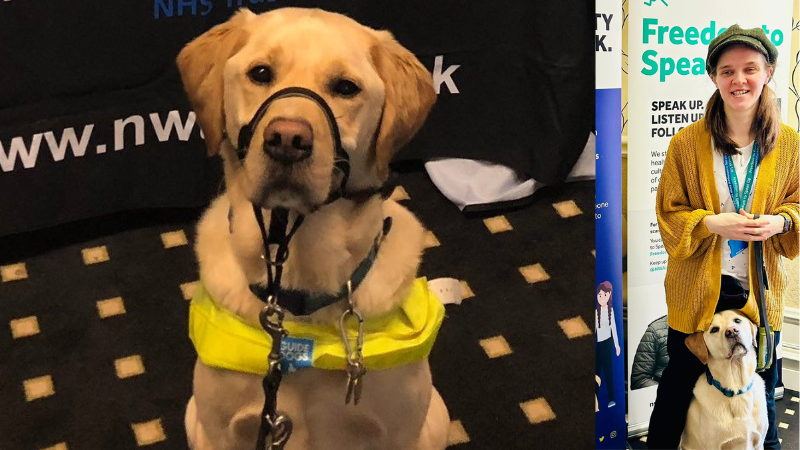
- Don’t interact with a working dog by petting, calling out the dog’s name, or giving the dog cues. A guide dog should only hear cues from its owner.
Fran says: “If Sean is distracted when out and about it can put us both in danger, he is trained to focus on what I’m saying and assessing if the path ahead is safe.
“Imagine you are trying to concentrate and make a decision in constantly changing circumstances then someone shouts at you, it’s going to distract you and impede your decision-making.”
2. Do teach children the difference between a pet and a working guide dog.
Fran says: “When I come across children who want to pet Sean, I approach it differently to adults. I explain to them that Sean’s harness is like his school uniform. So just like when they wear their uniform at school, they are supposed to behave a certain way and follow rules, this is the same for Sean.
“If I have time, I’ll always offer to take the harness off demonstrating the difference in his behaviour out of it, then allow them to pet him.”
3. Don’t allow your pets to interact with a working guide dog. When a Guide Dog is working in harness you should avoid your pet dog interacting with them as it may distract them just like a human would.
Fran says: “If a dog demonstrates aggressive behaviour, it may be unsettling for guide dogs and, in some cases, they can lose their nerve and be unable to work again. Some guide dogs learn to stand still until a pet dog has walked past however in some situations, they may continue but go to the other side of the pavement to avoid interaction in this situation. If possible, walk your dog on the side furthest away from the working dog.
“When a guide dog is not working and off lead, they interact with other dogs, however, they have a cautious nature, so it is important to keep an eye on your dog if interacting with a guide dog free running.”
4. Don’t feed the dog anything without the handler’s permission, especially not table scraps.
Fran says: “Guide dogs must maintain an ideal weight and fitness level, not to mention food being a natural distraction from work.
“Sean is on a special GI diet as he has a sensitive stomach so feeding him scraps and food not included in his diet can make him unwell and unable to work. It is also important that he maintains a good working weight to avoid any excess weight putting strain on his joints when walking.”
5. Don’t attempt to guide, steer, or hold a person navigating with a guide dog.
Fran says: “If someone attempts to guide me/give directions this confuses Sean, he will stand still and stop guiding me. When I am being assisted for example at train stations, I drop the harness and just hold Sean’s lead this indicates to him I don’t need him to guide me for this part.”
6. Do ask permission to pet the dog or to allow children to pet the dog if the dog is out of harness and not working.
Fran says: “Many guide dog owners including myself are unable to see when people pet their dog in and out of their harness, so we appreciate anyone asking as it demonstrates that they respect the boundaries you have in place with the dog.”
7. Do walk on the owner’s right side, a few paces behind when sharing a pavement.
Fran says: “Walking on the left side (the dog side) may distract the dog. Maintain a safe distance and give them enough space to move freely. Avoid getting too close or walking directly in front of them, as it can disrupt the dog’s concentration and hinder their ability to safely guide the owner.”
8. Don’t grab or hold the dog’s harness.
Fran says: “It is essential for the owner to maintain control of the guide dog’s harness as it is how they communicate with their dog. Never attempt to grab or hold onto the harness, as this can interfere with the dog’s ability to guide effectively.”